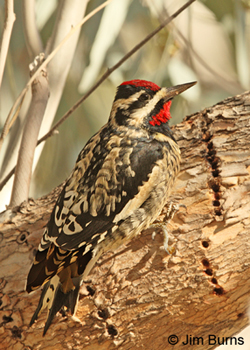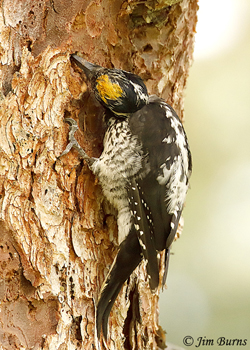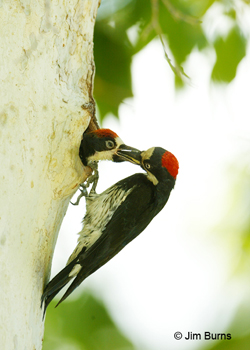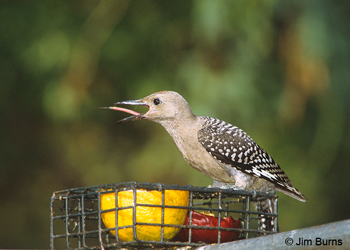Yellow-bellied Sapsucker, the driller |
American Three-toed Woodpecker, the flaker |
So, my response to this question is owls, woodpeckers, and grouse, and in that order. Owls of course check both my fascination boxes, and there are multiple books about the family detailing why and how they do. While you don’t need to carry a flashlight and/or get lucky to see woodpeckers, the woody family certainly has evolved enough extraordinary physical characteristics to warrant close observation and endless wonder. Actually, six to be exact, and the most obvious one may not even be the most important.
Zygodactyl feet
Woodpeckers are arboreal, of course, but if you’re a bird photographer one of the first realizations that comes with shooting this charismatic family is that they are best portrayed vertically, not horizontally like most birds that spend their life in trees. Woodpeckers are upright. The answer to why is the same as it is for all avian species. It gives them access to a food supply not readily available to other birds. The answer to how is much more interesting, and it has two parts, zygodactyl feet being the most important.
If you’ve ever watched the arborists trimming palm trees, you know they are equipped with climbing spikes and a safety belt. Zygodactyl feet, two toes forward and two toes backward, are the woodpeckers’ spikes, the evolutionary adaptation which allows them to climb vertically and maintain a solid grip on vertical surfaces as they search for arboreal insects along tree trunks, branches, and in the interstices of the bark.
Tail feathers
Woodpecker tails are unique in the North American avian world, but like those of the woodcreepers of the tropics whose tail feathers are stiff and barbed, features that perfectly compliment the zygodactyl feet. As woodies drum, excavate, or ply the bark for food, the tail is pressed against the tree, bracing the bird in its upright posture, then acting as a prop or platform as it hitches up the tree to a new position. Thus, the tail functions just like the tree trimmer’s safety belt.
The central tail feathers are curved slightly downward, and the tips are stiffened into a point. The net effect of this for a woodpecker at work is to provide the body with a tripod. Two feet (with spikes) and the barbed tail make up three anchor points to keep the bird from falling off the tree. Next time you have a woody in your binoculars, sidle around the tree and get a side view of this tripod so you can see how much daylight, or air, there is between the feet and the tail beneath the bird’s vent area. Only the very tip of the tail will be flush with the tree’s trunk.
Chisel bill
Alright, the long, straight, chisel shaped bill may be the woodpeckers’ most visually obvious structural feature, the trait which allows the family to do what it does and for which it is named. But note that a chisel does not come to a fine point which might bind in the wood and be damaged or broken off. The chisel shape allows woodies to pound, probe, drill, and drum while still absorbing and spreading out the shock of excavating and digging.
Close inspection of various woodpecker species will show that the exact size and shape of the bill is further evolved to accommodate the hardness of the wood in the species’ preferred habitat and the exact task for which it has evolved, literally drilling into, pun intended, evolution’s fine specificity. American Three-toeds flake Ponderosa Pine, Gilded Flickers probe cactus and dirt, Ladder-backeds use paloverde and willow, Williamson’s Sapsuckers live in aspen. All have slightly different bill sizes, shapes, and thicknesses.
Shock absorption
If you watch and listen to woodpeckers in action, it becomes hard to fathom the shock their activities must transfer to their head. For this seemingly brutal work, they have evolved three modifications not found in other birds. Woodpeckers have larger skulls which house an enlarged brain case, folded frontal bones at the base of the bill, and stronger muscles behind the bill, all designed to cushion shock and spread it out.
Remarkable tongue
To the benefit of their foraging style, many members of the woodpecker family have a tongue that is long, sticky, barbed, and extremely extensible. Imagine the advantages of these adaptations if you were exploring holes in wood or the ground made by boring insects. Now imagine being an ant or one of those insects as this lethal weapon probes around for you inside your home with no escape hatch.
These tongues are attached to two strips of cartilage that wrap entirely around the skull and anchor into the nostrils or eye sockets. Some flickers can extend this marvelous tool five inches outside the bill, and the cartilage also doubles as further shock absorption for the head.
Feathered nostrils
The next time you encounter a woodpecker excavating a tree cavity, watch carefully. Wood chips fly everywhere. The avian carpenter closes its nictitating membrane to protect its eyes, but the species that excavate most heavily into the wood have also developed nostrils that are more fully feathered, have larger nasal tufts to keep wood chips out, and their nostrils may be very narrow or even hidden beneath a bony ridge.
Acorn Woodpecker female feeding nestling, the tripod |
Gila Woodpecker juvenile, the tongue |



